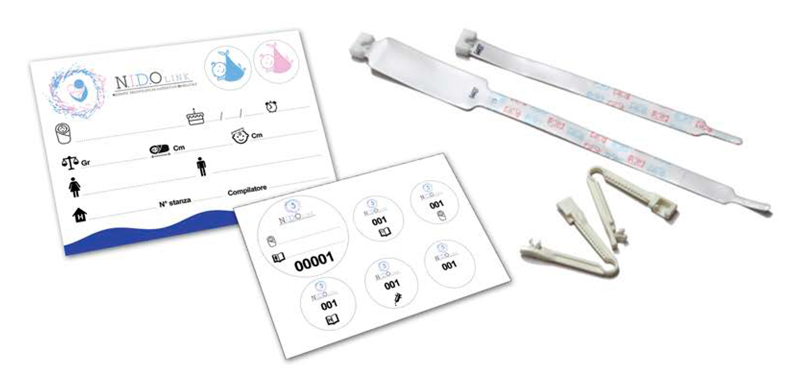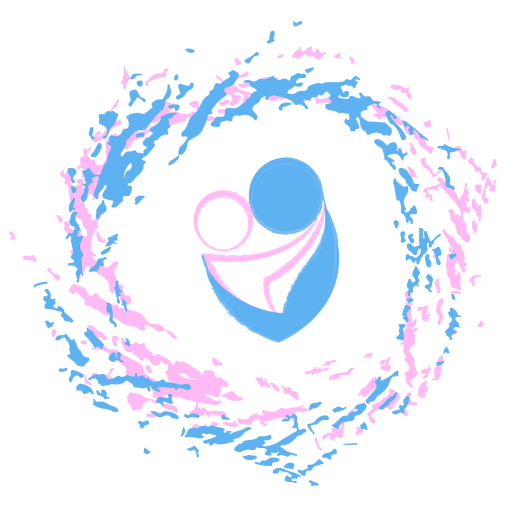
NIDOLink is a kit and a patented procedure, which guarantees SAFE identification of Mother-Newborn, in the Delivery Room from before the umbilical cord is cut, during hospitalization and upon discharge from the NURSERY.
Uniqueness, advantages and benefits:
- it is an innovative patented procedure;
- it is a Safe procedure, The bond between mother and child is never interrupted from before the cut of the umbilical cord to discharge;
- The identification of the newborn and the mother is unequivocal even in the event of slipping / loss of the newborn’s bracelet;
- Low cost;
- Easy to use;
- High quality of components.

Why choose NidoLink?
Premise
In Italy about 500 thousand newborns are born every year and although, there are no precise data on the exchange of newborns, the number could paradoxically be reconstructed through the recurring press reports, given that these cases generally have a strong media coverage both in Italy and abroad. ‘abroad. In Italy In 2002, following a sensational case of baby exchange, which took place in Sicily
in 1998 and casually highlighted in 2001, the Ministry of Public Health in the Gaz .. Uff. No. 19 of 23/01/2002, the guidelines for mother-child identification.
The legislation in summary provides for two bracelets with the same number, originally joined and of different sizes that will be separated and applied to the puerpera and newborn (on the wrist or preferably on the ankle of the newborn) immediately after birth, spontaneous or operative and in any case inside. the delivery room or the operating room. Despite the aforementioned current legislation, cases of cradle swapping continue to be reported, often resolved in the first days of life, thanks also to the extreme attention of parents. There have also been reports, even recently, of dramatic cases of cradle swapping discovered by chance even after decades, these are hidden cases of which no one knows the extent. The foregoing has resulted in regular claims for compensation, including millionaire, from the structures.
Cost analysis
After examining many national and foreign news cases with medical and nursing experts, we have identified critical moments in the identification process.
In particular, three critical moments have been identified:
DELIVERY ROOM:
– When several parties occur simultaneously (within 10 minutes); the percentage of this event is relatively rare, (about 1/40 spontaneous deliveries),
– Serious neonatal complications at birth involving interventions on the newborn, which can distract the attention of operators from the identification process.
– Night hours, due to the decrease in attention of operators that can occur due to the circadian rhythm.
DURING STAY:
-In the Nursery, in moments of aggregation, when newborns are undressed to be washed or examined, due to the slipping of the neonatal bracelet, reported in 10-20% of births, and the loss of the bracelet reported in about 1/100 newborns. This occurrence, which often occurs during undressing, is due to 2 factors; to bracelets that are left too wide, to prevent them from causing damage to blood circulation; and to the physiological decline that physiologically reduces both the circumference of the hands and feet.
DISSEMINATION:
-The exchange of clothes;
– The early elimination of the neonatal bracelet, upon discharge, which does not allow to verify, even at home, the correspondence of the identification number.
In order to improve the safety of the procedure, we have adopted a new patented “NIDO LINK” system which, in summary, allows you to connect the kit to the mother before entering the delivery / operating room and to identify the baby at birth before birth. cutting of the umbilical cord, with a clamp with the same number of the neonatal cuff and of the mother, which will guarantee, until arrival at home, a safe mother-child identification.
Conclusions
Although it is difficult to assess the risk today, the frequent presence in the news about cradle swapping shows that current regulations need to be improved. In addition, making the mother / child identification procedure safer helps to make parents and operators more serene and to improve the quality of the department and structure. Our innovative system makes mother-child identification safer, intervening on the critical moments of the process. The advantages over the standard kit, the Patented Nido / link system, optimizes both the effectiveness of the process in terms of safety, prevention and image, and efficiency with a reduction in risk and medico-legal costs.
In evaluating the costs compared to the traditional kit, the high quality of the materials, the sterility of all components, the savings due to the purchase of clamps not included in the standard kits, and the savings in surgical instruments must also be assessed.
Useful information
Contact
Fill out the form below to request information

